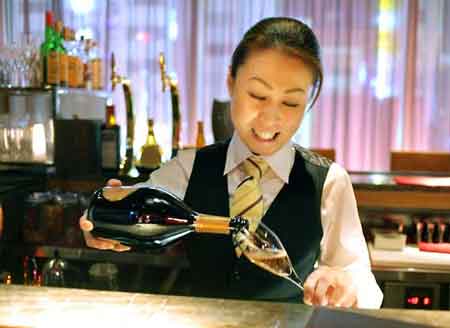
My Kindred Wine-Spirit in Tokyo
As you may have seen in my previous blog posting, I had the opportunity to celebrate the arrival of the 2008 Beaujolais Nouveau earlier this month in Tokyo. See:
https://vintagetexas.com/?p=186.
Little did I realize that I would find my kindred spirit there, too, in the likes of Steven Spurrier.
Spurrier is now Consultant Editor of Decanter Magazine. He also organizes the Japan Wine Challenge that was held this year at the Sheraton Miyako Hotel in Tokyo. The Japan Wine Challenge is the most prestigious wine competition in Asia providing a head-to-head competition among the wines of Japan and Asia and those from leading producers in the western world.

Does this format sound somewhat familiar?
Like maybe…The Judgment of Paris?
Spurrier is undeniably best known for organizing the famous blind tasting and wine judging in Paris, France in 1976. This event involved a selection of California Cabernet Sauvignons and Chardonnays pitted against a well known contingent of French wines from Bordeaux and Burgundy. The choice by the judges of several California wines over the French wines is often referred to as “The Judgment of Paris” and catapulted California to fame as a premier wine producing region. This event was recently made (with a bit of artistic license) into the movie – “Bottle Shock”.
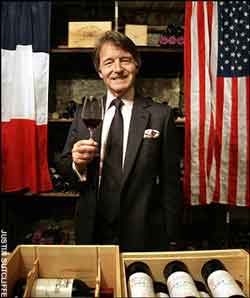 Interesting factoids associated with the Paris event are numerous. For example, Spurrier invited many reporters to cover this judging, but the only reporter to attend was George Taber from Time magazine. Taber promptly revealed the results to the world.
Interesting factoids associated with the Paris event are numerous. For example, Spurrier invited many reporters to cover this judging, but the only reporter to attend was George Taber from Time magazine. Taber promptly revealed the results to the world.
In response to Spurrier’s actions, leaders of the French wine industry then banned him from the nation’s most prestige wine-tasting tour for a year, apparently as punishment for the damage his tasting had done to its former image of superiority.
However, the French then said that the real test for the red wines would come in 30 years’ time when they would be fully mature – then real judgement would be reached. Well, the “Judgment of Paris – Part Deux” took place in 2006 with much the same results as in the initial judgement.
Another interesting aspect of the tasting was, at the time of the first Paris tasting, Spurrier was a purveyor of French wines. Some people involved with the tasting suggest that he did not actually expect that the California wines would out score the French wines in the competition. But, this was of little consequence….the die was cast. Literally overnight, the results of this competition put California in a prominent position on the global wine map.
It sounds like Spurrier is up to his old tricks again, but now in Japan.
Spurrier – My Kindred Spirit
I think of Spurrier as a kind of kindred spirit. I have studied his 1976 Paris tasting and have used it as my inspiration to do blind tastings and competitions involving Texas wines. Not only Texas wines versus Texas wines, but head-to-head competitions of Texas wines versus medal-winning wines from around the world.
My experience has been that, if judges (or wine critics, for that matter) know that they are tasting exclusively Texas wines, they often have preconceived notions that they cannot overcome. This knowledge generally leads to a more negative mindset and suffering scores for the Texas wines.
In blind tastings of Texas wine versus notable wines from around the world, two things happen. First, the playing field is leveled – the judges do not know if the wine being tasted from any particular glass is from Texas or some well a respected winery from a longstanding producing region. Therefore, the wine judge figuratively has the “gun to his head”, and must provide a simple, straightforward, yet critical evaluation based solely on the sensatory experience provided by each wine whether from Texas or not. Sounds fair to me.
Secondly, by including non-Texas “ringers” (typically involving respected brands, highly-rated by major wine publications and gold medal winning wines from major competitions), the competition results have an automatic benchmark with respect to quality and price point in the global marketplace. This provides instant credibility for the winning Texas wines in the eyes of both the judges and the consumers. In summary, comparative and blind tastings (and competitions) lead to a better experience for all parties involved and a more honest and benchmarked evaluation of Texas wines.
For descriptions of two major events that I have organized in the past that have used Spurrier’s techniques, go to the following previous blog postings:
The Judgment of Houston – https://vintagetexas.com/?s=judgment : This is series of three posts in reverse order that describe the Texas’ Best Wine Competition blind tasting that used a panel of professional judges and a slate of highly-rated non-Texas ringers.
Shoot Out at the O.K. “Wine” Corral – https://vintagetexas.com/?s=Corral: This post describes a blind tasting held at a French culinary school in Houston – Six French Bordeaux and six Texas Cabernet/Merlot-based wines. The judging panel consisted of about 50 professional and “recreational-yet-knowledgeable” tasters who attended the event. They included area chefs, a host of Francophiles and Texas wine consumers.
In a similar vein, the Texas Department of Agriculture has taken to using this blind tasting philosophy in doing what they refer to as the “Texas Two-Sip” (See: https://vintagetexas.com/?p=19). These tastings involve groups of two wines, one from Texas and one not, poured side-by-side from masked bottles. Then, the tasters have to determine which one is the Texas wine and which is not.
I recently witnessed the Texas Two-Sip during and Texas Sommeliers’ Conference in Austin. The tasters in this case were representatives of wine distributors and restaurant sommeliers from around the state. The response from the tasters was overwhelmingly positive. Some picked the origin correctly, but many were unexpectedly “fooled” by the quality of the Texas wines.
Back to the Japan Wine Challenge
I found the results of Spurrier’s Tokyo wine competition to be very interesting and informative. The list of awards showed that Japan is making western-style wines that are becoming competitive with the likes of:
Trapiche Malbec – Argentina
Piper-Heidsieck Champagne Cuvee Brut – France
Brunello di Montalcino DOCG Pian Dell’Orino – Italy
Villa Maria Private Bin Sauvignon Blanc – New Zealand
Borsao Clasico Tinto – Spain
Heitz Wine Cellars Napa Valley Cabernet Sauvignon – USA
These are names that most wine consumers know and respect.
2008 Wine Challenge Top Awarded Japanese Wine
The highest scoring Japanese wine in this year’s competition was Grace Merlot 2006. Not knowing much about Japanese wines I made an effort to find information on this winery and purchase the award winning Merlot while I was in Tokyo. Being in Aoyama near Shibuya Station, I took a taxi to Tokyu, one of the urban department stores with an excellent wine section. Evidently, there had been a run on the Grace Merlot after the competition results were made known in Tokyo earlier this year. Tokyu was sold out of the award winning wine. But, the manager of the wine section recommended two wines from Grace for me to taste:
Grace Koshu 2008 (about US$ 16)
Grace Cuvee Misawa 2004 (about US$ 85)
While the prices for these wines were a bit on the steep side, so are the prices for most everything thing in the Tokyo area and also in Japan right now due to the very strong Yen versus the US dollar.
Background: Classic Varietals vs. Koshu
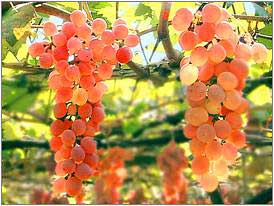 In 1923, Chuo Budoshu (currently using the brand name Grace) was established in Katsunuma in Yamanashi prefecture, the birthplace of the Japanese wine industry. Grace is making western-style wines from estate-grown grapes that include the classic varietals: Cabernet Sauvignon, Chardonnay, Merlot, Petit Verdot and Pinot Noir. In addition, they also make wine from Koshu, a traditional Japanese grape varietal. The growing region utilizes the local terroir provided by the mountain soils and climate to make high quality wines. This terroir includes a unique microclimate caused by the rain-shadow of Mount Fuji that mitigates the high annual rainfall experienced on the island of Japan.
In 1923, Chuo Budoshu (currently using the brand name Grace) was established in Katsunuma in Yamanashi prefecture, the birthplace of the Japanese wine industry. Grace is making western-style wines from estate-grown grapes that include the classic varietals: Cabernet Sauvignon, Chardonnay, Merlot, Petit Verdot and Pinot Noir. In addition, they also make wine from Koshu, a traditional Japanese grape varietal. The growing region utilizes the local terroir provided by the mountain soils and climate to make high quality wines. This terroir includes a unique microclimate caused by the rain-shadow of Mount Fuji that mitigates the high annual rainfall experienced on the island of Japan.
While cultivation of classic grape varietals is relatively new in Japan, the Koshu grape has a long history there. The original Koshu grapes, were a strain of Vitis Vinifera similar to Europe’s great wine grapes. They were brought from the Caucasus through the Silk Road and spread into Japan with Buddhism reportedly over a thousand years ago. They took root in Katsunuma, where the natural terroir around Fujiyama is most suitable for grape growing. Koshu grapes skins also have a slight anthocyanin pigmentation resulting in a pink coloration when ripe, but the resultant wine is a white wine.
The Tasting: Grace Koshu 2008 (Yes….2008)
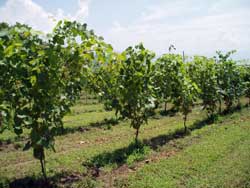 Being that the Koshu grapes were likely harvested in early September 2008 and it was now only November 2008, this wine qualifies as a Nouveau wine. This was actually fitting since the date of my Japanese wine hunting expedition was the date of the release of the 2008 Beaujolais Nouveau (the 3rd Thursday in November).
Being that the Koshu grapes were likely harvested in early September 2008 and it was now only November 2008, this wine qualifies as a Nouveau wine. This was actually fitting since the date of my Japanese wine hunting expedition was the date of the release of the 2008 Beaujolais Nouveau (the 3rd Thursday in November).
The Koshu wine was dry, young and fresh. The color was that of sun-bleached straw, similar to that observed in Pinot Grigio. The fruit aromas and flavors were those of light citrus (lemon and grapefruit) and herbs (chopped Italian parsley). There was also a touch of that yeasty aroma common in recently fermented, Nouveau-style wines. When the bottle was initially opened, it had a slight hint of carbonation that fleeted rapidly thereafter. In many respects, it was similar to the young “green” (Vino Verde) wines of Portugal that I have sampled both in Houston and especially on a stay in Lisbon.
The Tasting: Grace Cuvee Misawa 2004
The Cuvee was a blend of Cabernet Sauvignon and Merlot. When poured in the glass, it had a medium body and red-purple color and pink rim. While being medium bodied, the wine had a slight, but noticeable opacity. Either the wine was not completely filtered or it had a minimal set of sediment developed during bottle aging. The aroma was of ripe plum and fresh raspberries with a hint of clove spice. The taste followed with similar characteristics true to its nose.
The most striking quality of the Cuvee Misawa was the combination of its lighter body and the acidity that is generally uncharacteristic of the super-ripened, Cabernet and Merlot fruit-bombs made by New World wineries. Accordingly, the Grace Cuvee Misawa may leave the western palate unsatisfied with this wine as a pairing with full- flavored, meat-dominated cuisine. But, if you have ever experienced a Japanese pickled plum (a delicacy in Japan) and tasted the acidic, briney fruit sensations, you will immediately recognize why this wine may hit the mark with Japanese wine drinkers.
Wines Compatible with Japanese Tastes and Cuisine
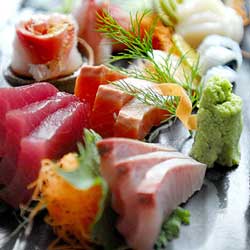 Characteristically, Asian cuisines use meat, not as a dominant theme, but in a supportive role as a condiment. In this regard, the meat is used in lesser quantity and in context with vegetables, rice or noodles more for its savory characteristics (in Japan referred to as “Umame” – The fifth taste sensation after sweet, sour, salt and acid) and for a tactile counterpoint on the palate. In this context, a lighter-style Bordeaux like the Grace Cuvee Misawa is completely to be expected and in balance with how red-meats (including raw or seared tuna) are presented in Japanese and other Asian cuisines.
Characteristically, Asian cuisines use meat, not as a dominant theme, but in a supportive role as a condiment. In this regard, the meat is used in lesser quantity and in context with vegetables, rice or noodles more for its savory characteristics (in Japan referred to as “Umame” – The fifth taste sensation after sweet, sour, salt and acid) and for a tactile counterpoint on the palate. In this context, a lighter-style Bordeaux like the Grace Cuvee Misawa is completely to be expected and in balance with how red-meats (including raw or seared tuna) are presented in Japanese and other Asian cuisines.
Having traveled extensively in Japan for almost 30 years, I can say that both of the wines in this tasting were completely in tune with the local cuisine and likely the tastes of most Japanese. Koshu makes a superb accompaniment to light, uncooked delicacies like sushi and sashimi, steamed or sautéed vegetables and seafood, and other light regional fare. Likewise, the Cuvee Misawa is a reinterpretation of the classic Bordeaux blend (lighter bodied and higher acidity) to be more compatible with Japanese style meat preparations.
In Closing….
All in all, this was a much unexpected and fulfilling wine experience in Japan with teachings for Texas winemakers, too.
Teaching 1 – To gain wine respectibility, you have to challange the world.
Teaching 2 – Success comes to those that make wine in harmony with the local cuisine.
Hopefully, next time, I can come face-to-face with my kindred wine spirit Spurrier, compare notes with him, get a few more tips for upcoming Texas wine tastings, and maybe participate in his Japan Wine Challenge. Or, maybe invite him to Houston to take on Texas wines as his next project.

I love tokyo and Naruto.